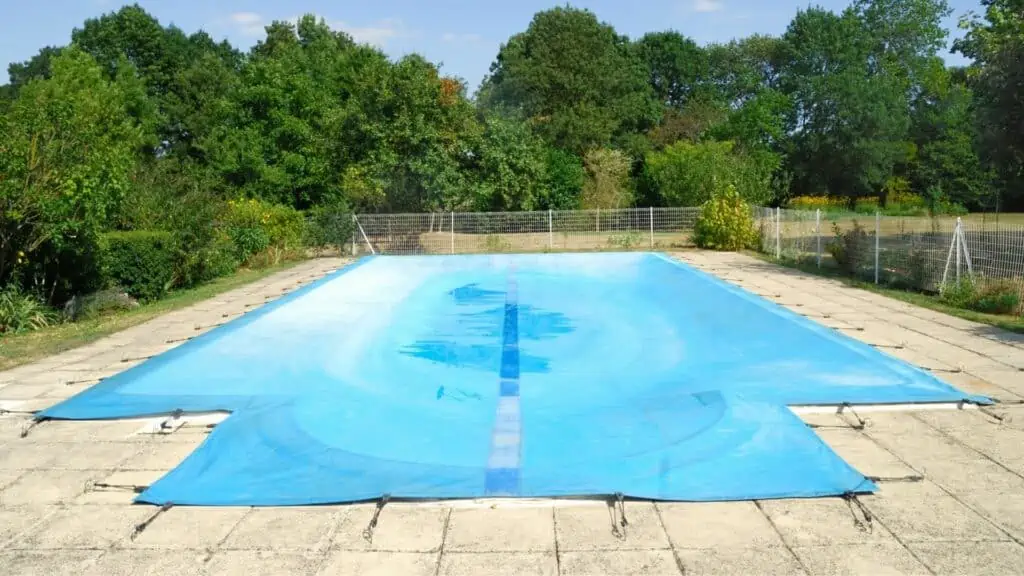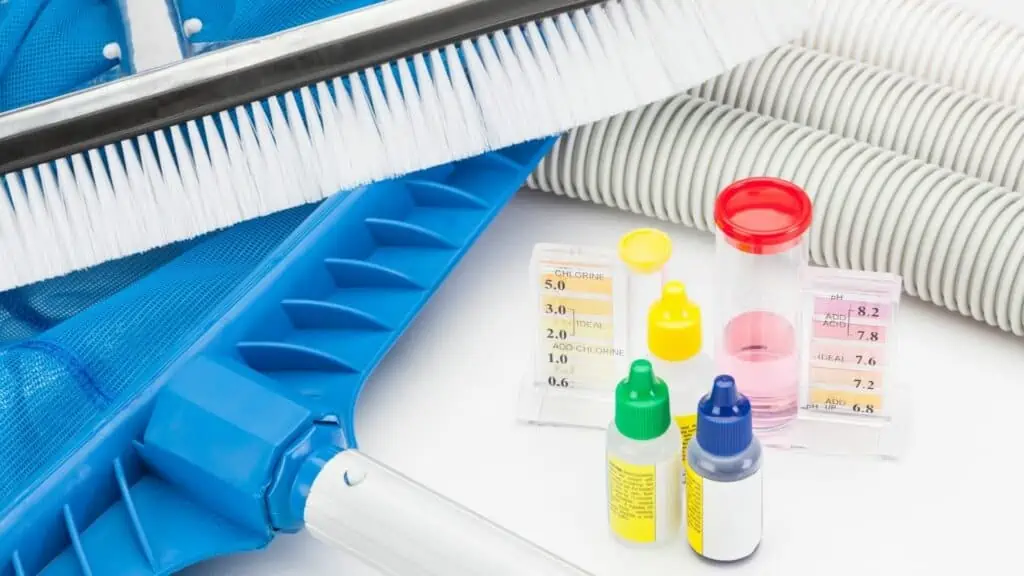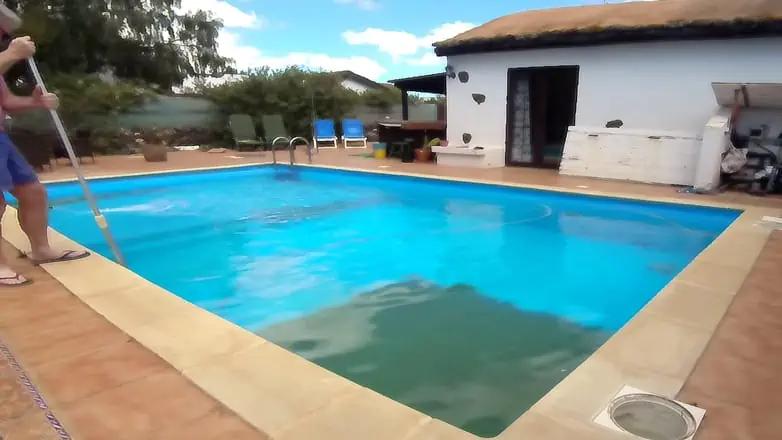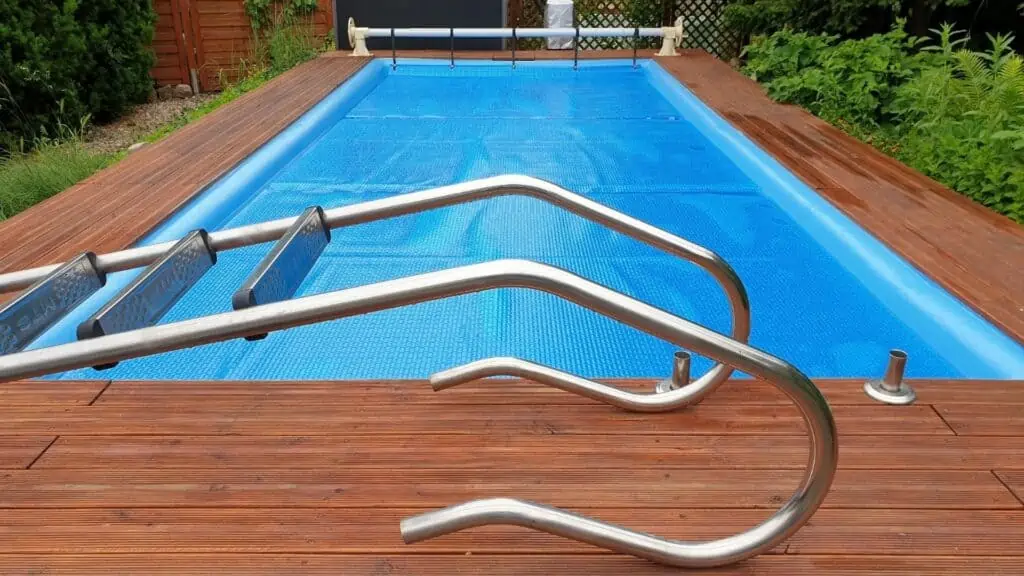So you’re finally ready to use your inground pool (or above-ground pool) after a long, cold winter, and you’re wondering how to open a swimming pool.
Opening a swimming pool can seem daunting, but it’s a task that many pool owners can handle without professional help.
Whether you have an in-ground or above-ground pool, the approach to opening it up after winter is similar, and the amount of work involved largely depends on your climate. In colder regions, you must take extra precautions to prevent damage.
Our guide will walk you through the essential steps, from cleaning the cover to balancing chemical levels, ensuring a smooth and successful pool opening.
Well, we’ll be going over:
- What are the necessary steps to prepare your pool before removing the cover?
- How can you efficiently clean and maintain your pool during the opening process?
- What are the best practices for balancing your pool’s chemical levels to ensure a safe and enjoyable swimming environment?
Let’s get your pool ready for a season of fun and relaxation!


The week before you open the pool
If possible, you should lift the edge of the pool cover-up, perhaps a week before you open the pool, to see what state the pool water is in.
If it is clean and clear, then great, there is nothing more to do before opening your pool.
If the water is green due to algae, or you can at least see some algae growth on the sides, then give the pool water a dose of liquid shock (a double shock if the water is very green). This will hopefully mean that the algae will die in a week when you go through the process of opening your pool.
Also read: Easy guide to pool startup chemicals
Things you will need to open your pool
Here is a list of everything you need for pool startup to ensure this gets done quickly. Here’s what you will need:
- A soft brush
- Pool cover pump
- Winter cover cleaner
- Pool brush
- Manual pool vacuum
- Pool equipment (ladders, diving board etc)
- Test strips or test kit

How to open a pool for the season
Step 1: Clean your pool cover
Assuming you have covered your pool for the winter, your pool cover will likely be covered with leaves, dirt and dust from the winter season, which will need cleaning up before you even think about removing the cover.
If you have a pool cover pump, now is the time to use it. This device will suck up any standing water on the cover plus any dirt and debris that is also in the way. Use a soft brush to sweep any other messy bits manually.
Step 2: Remove the cover
You must now remove the winter pool cover for a deep clean. To do this, you may need help moving the entire cover to a flat area. Once your pool cover has been successfully removed, use cover cleaner and a soft brush to remove any remaining dirt.
This is also a good time to inspect the material for wear and tear. Winter pool covers are generally durable, but that doesn’t mean they are invincible! You may want to purchase a new one if you notice any rips or holes. If true, you won’t need to spend time deep-cleaning it!
Step 3: Time to inspect
Pool season may come to an abrupt end if you fail to spot damage. That’s why we have compiled a short list of ‘to-do’s’ so you don’t miss a thing.
- Inspect the deck and tiles for chips or cracks.
- Don’t forget to reinstall any pool lights that were removed when closing. Swimming at night won’t be the same without them!
- Do the return lines, filter or pump need replacing? Now’s the time to check for damage.
- Take a look at your pool tiles and remove any scum or stains with a household tile cleaner. Baking soda is a fantastic stain remover that works a charm.
Step 4: Clear debris from the water
Using a net, skim the swimming pool for any debris that may have fallen in during the removal of the winter cover. If the winter cover is damaged, you may find small dirt particles in the water.
Step 5: Remove winterizing plugs
When winterizing a pool, the pipes are normally plugged to prevent water from entering and freezing during the colder seasons. Make sure you place all plugs somewhere safe so that you won’t lose any and don’t have to hunt for them at the end of the pool season!
When you open a pool, you must put the drain plugs back in place. Opening your return side valve is essential as this allows water to enter from the pump. If your pool has a multiport valve, you must choose the ‘waste’ option and replace the sight glass, pressure gauge and air bleeder.
As the water rushes back into the pipes you may see some movement or bubbles in the pool water. This is normal and a small sign of your pool returning to life!
Step 6: Fill pool water
During the winterizing process, it is not uncommon to drain your water level slightly below the skimmer. This reduces the chance of damage caused by ice expansion. You must raise these levels again by filling the pool up a few inches using a garden hose.
This part should always be done before adding chemicals or filtering. A garden hose filter is the best way to ensure the water is not contaminated with metals or other unwanted chemicals.
Step 7: Balance chemical levels
The water chemistry in your swimming pool may not be too bad if you have regularly tested it during the colder months. If not, there’s no need to worry, as it won’t take long to settle these levels again. If this is your first time opening a pool, you may want to purchase the following pool chemicals:
- Chlorine
- Algaecide
- pH increaser
- pH decreaser (baking soda or soda ash)
- Pool shock
- Clarifier/Flocculant
- Metal sequestrant
- Calcium hardness increaser
- Alkalinity increaser
They will be available in your local pool supply store or online. Let’s briefly examine what your levels should look like when balanced. You can buy a whole kit of startup chemicals on Amazon – In The Swim Super Pool Opening Chemical Start Up Kit
Total alkalinity (TA)
This is the water’s ability to neutralize acids and should be between 80 and 120 ppm.
pH level
The pH level of pool water is very important and can irritate the skin and eyes when it is too high or too low. A good pH level should be between 7.2 and 7.6.
Calcium hardness
We don’t want to go too deep into the science of calcium hardness, but an imbalance of calcium can cause significant damage to a pool.
Too much calcium can cloud the waters and leave scale lingering on your tiles and equipment. Low calcium levels aren’t appealing, as the water will attack plaster pool walls, metal fittings, and heat exchangers.
However, you only need to know that it should be between 200 and 400 ppm (parts per million).
Free available chlorine
Free available chlorine is chlorine that hasn’t yet reacted with contaminants. A good level is anywhere between 2.0 and 4.0 ppm.
The difference between the different chlorine terms can be confusing, so read my post Free Chlorine vs combined chlorine vs total chlorine, which will hopefully explain it fully.
Cyanuric Acid (stabilizer)
Cyanuric acid (CYA) is one of the most important chemicals in any swimming pool and is commonly called ‘pool stabilizer’‘. This should be between 30 and 50 ppm.
To read all about it in my post – Cyanuric acid: What is it and how to use it
Step 8: Vacuum the pool

It’s now time to scrub your pool from top to bottom! Brushing the walls of the pool will remove any stubborn scum or algae that has grown during the winter. Vacuuming your pool manually is recommended as opposed to using an automatic pool vacuum at this point.
This step aims to remove as much dirt and debris as possible to ensure your pool is clean and ready to swim in. If the pool is very dirty now, perhaps with dead algae, you must vacuum to waste.
Step 9: Add chlorine shock
Adding some shock treatment to the water is the best way to clear up a cloudy-looking pool quickly. Not only is this product great for cosmetic reasons, but pool shock also works to eliminate algae and microscopic bacteria. Here are a couple of different ways to use it.
- You can pour pool shock directly into the pool if it is liquid shock or if the instructions on the packet say it is okay. A good rule of thumb is to pour it a few inches away from the pool wall so that it disperses evenly throughout the water.
- The other method is to fill a bucket with pool water and add pool shock before pouring it into the water.
Read the instructions on the back of the bottle to indicate roughly how much shock you will need to use. We wouldn’t recommend combining a mixture of pool shock products as this may cause a chemical reaction.
Step 10: Turn on pool filter and pumps
Before powering up, it is wise to inspect the filtration system and other components for leaks or damage, including return lines and the filter. Clean any debris in this area before switching the pool on. Also, check your solar heating panels for leaks if you have them.
Once you have completed a thorough inspection, turn on your pool pump and filter to get the water circulating. Filtering the water will eliminate leftover dirt and debris, such as pool algae and other bacteria.
This is a good time to check again for any leaks or cracks. If you do come across any leakages, shut the power off immediately.
Step 11: Reinstall pool accessories

Now is a good time to ‘dress’ your pool with the usual accessories, including ladders, rails, diving boards, etc. Before installing, check each piece for signs of rust or damage.
You may want to use a metal lubricant such as WD-40 to loosen any bolts. This won’t affect the water chemistry.
Step 12: All done
Perhaps all you need to do now is switch on your heating if you have it or get your solar pool cover out of storage and put it on the pool to allow the sun to heat the water.
Sit back and get ready to enjoy a summer of pool fun.
The best time to open your pool
It only takes a slight rise in temperature and a glimmer of sunshine to get us fired up and ready to open your pool for the season, but when is the best time to open up?
This will depend on your climate, as you can open your pool much earlier in California than you will in Michigan.
You should consider opening your pool as soon as the weather gets consistently warmer or temperatures are 70ºF and above. Waiting too long will only give algae and other bacteria a chance to multiply in their millions.
Read: When to open a pool

How much does it cost to open a pool?
If you are opening the pool yourself, then it will not cost any more than the cost of some pool chemicals and your time too, of course.
If you use a pool service company to open your pool, then this can cost anything up to $400 on average. Labor is expensive.
How long does it take to open a pool?
You’ll probably spend a good few hours cleaning the pool, adding chemicals and installing equipment. Then, you must run the filter for 24 hours to get the water circulating.
After following the above instructions, you must wait at least 24 hours before taking your first dip of the year.
Frequently asked questions
Does a filtration system need to run for 24 hours a day?
Although you can run pool filtration systems 24 hours a day to keep the water clean and free from bacteria, that is unnecessary. You would use much more electricity that way and your pool pump will need replacing more frequently too.
You should run the pool filter system long enough each day to filter the entire volume of water once, which often means running the circulation system for between 6 and 8 hours.
For help in working out how long to run your pump read my post – How long should a pool pump run?
How often should I use algaecide during the summer?
Pool algae thrive in hot, moist conditions, so your pool is the perfect breeding ground! We recommended adding algaecide to the water every week during the summer. You may not necessarily be able to see algae growing, but prevention is better than cure.
Should I tend to the pool daily?
This depends on your situation (overhanging trees, windy, dusty, heavy rain). A pool owner should check the skimmer baskets once a day, check the pool level and see that the pump and filter are running smoothly. Read my pool maintenance article – Pool Maintenance schedule checklist
How often should I vacuum my pool?
We recommend vacuuming your pool at least once a week. Similarly, you might want to scrub the tiles above the waterline as they can become grimy and stained. This job can be made a lot easier if you purchase an automatic pool vacuum or, even better, a robotic pool vacuum.
See my post – How often should you vacuum a pool?





Leave a Reply